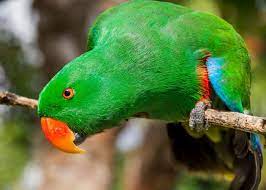The Eclectus Parrot (Eclectus roratus) is a stunning and unique bird species known for its striking sexual dimorphism. Native to the rainforests of Papua New Guinea, Australia, and some nearby islands, the Eclectus Parrot has captured the hearts of bird enthusiasts worldwide. In this blog, we will explore the fascinating world of the Eclectus Parrot, from its distinctive appearance and behavior to its conservation status and role in aviculture.
- Physical Appearance: One of the most remarkable features of the Eclectus Parrot is its extreme sexual dimorphism. Adult males exhibit bright emerald green plumage with blue and red patches on the wings, while females display vivid red and purple plumage with blue highlights. This stark contrast between the sexes initially led researchers to believe they were separate species.
- Habitat and Distribution: Eclectus Parrots are native to the tropical rainforests and lowland forests of Papua New Guinea, Indonesia, the Solomon Islands, and northeastern Australia. They prefer dense, lush vegetation where they can find an abundance of fruits, seeds, and flowers.
- Feeding Habits: The Eclectus Parrot’s diet consists primarily of fruits, nuts, seeds, berries, and nectar. They are known for their strong beaks, which they use to crack open nuts and seeds with precision.
- Behavior and Social Structure: Eclectus Parrots are generally social and intelligent birds. In the wild, they form monogamous pairs and are often seen in small flocks. They communicate through a variety of calls and are known for their vocal abilities.
- Breeding and Reproduction: Breeding pairs of Eclectus Parrots work together to build nests in tree cavities. The female takes the primary responsibility for incubating the eggs, while the male brings food to the nesting site. Once the chicks hatch, both parents actively participate in feeding and caring for them.
- Conservation Status: While the Eclectus Parrot is not currently classified as endangered, some subspecies face threats due to habitat loss and illegal trapping for the pet trade. Conservation efforts are in place to protect their natural habitats and promote responsible aviculture practices.
- Eclectus Parrots in Aviculture: Due to their striking appearance and charming personalities, Eclectus Parrots have become popular pets in aviculture. However, their unique dietary and social needs require knowledgeable and dedicated owners. Ethical breeding programs also play a crucial role in maintaining a healthy captive population.
- Vocalization and Mimicry: Eclectus Parrots are excellent mimics and can learn to imitate various sounds and words. Their ability to talk and mimic human speech makes them captivating companions for those who take the time to interact and train them.
- Caring for Eclectus Parrots: Proper care for Eclectus Parrots involves providing a balanced diet, spacious housing, mental stimulation, and regular veterinary check-ups. Interaction and socialization are essential for their well-being.
Conclusion: In conclusion, the Eclectus Parrot stands as a living masterpiece of nature, boasting an awe-inspiring combination of beauty, intelligence, and uniqueness. As we strive to understand and protect these magnificent birds, we ensure that future generations can marvel at the vibrant colors and captivating behaviors of the Eclectus Parrot in the wild and in our homes.




















Add Comment